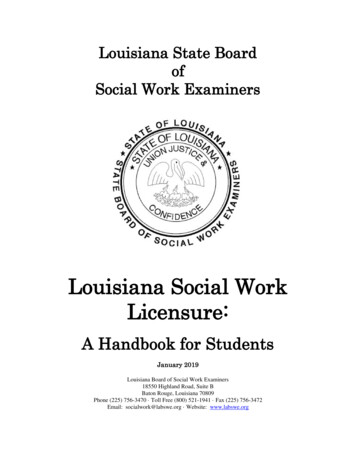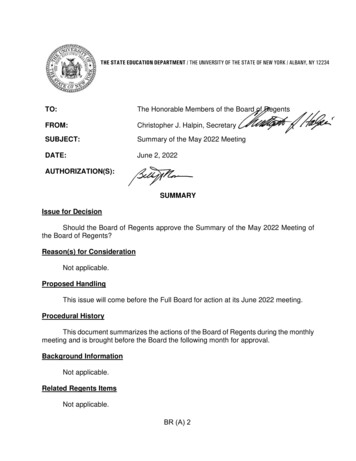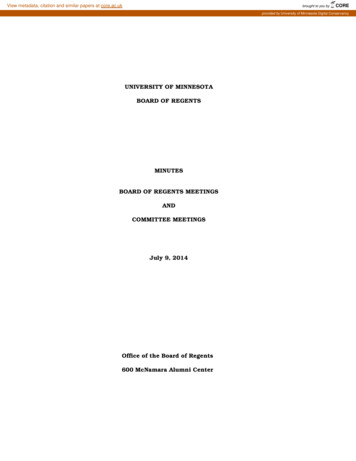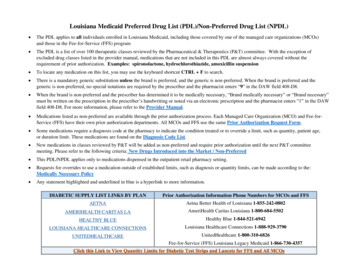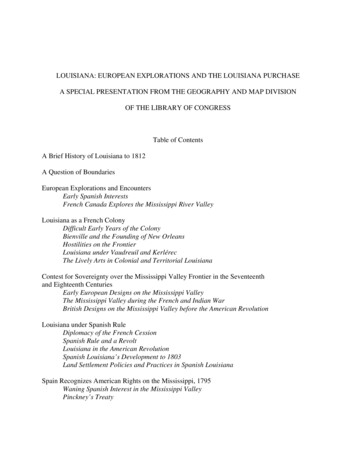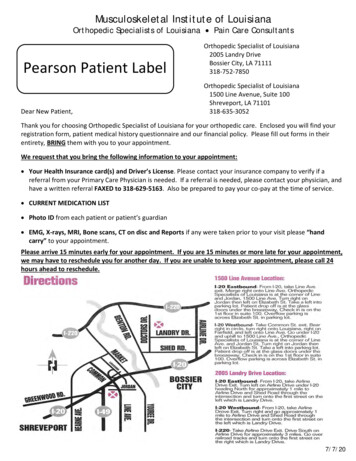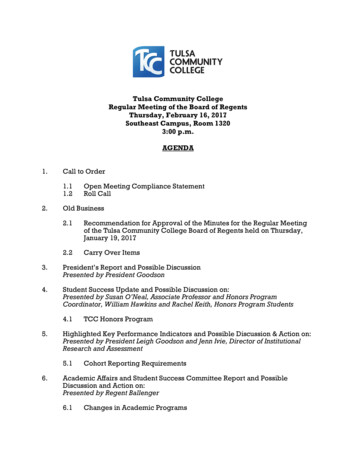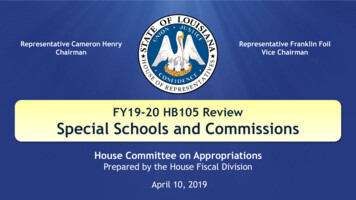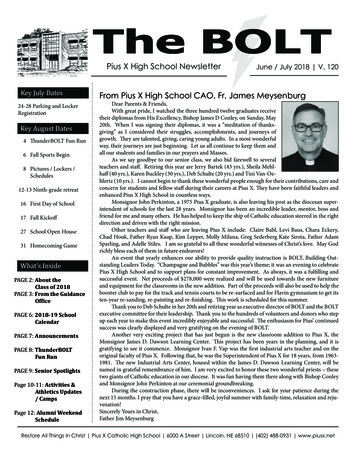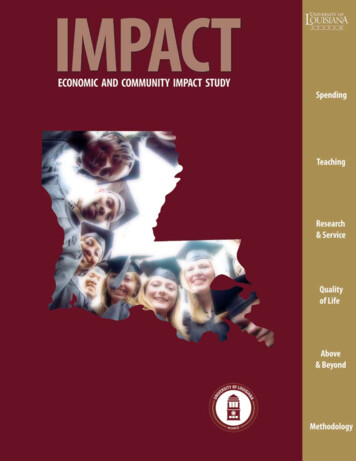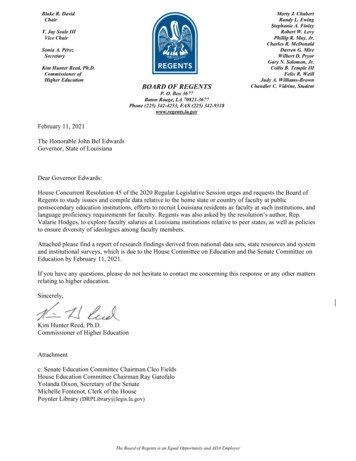
Transcription
Blake R. DavidChairT. Jay Seale IIIVice ChairSonia A. PérezSecretaryKim Hunter Reed, Ph.D.Commissioner ofHigher EducationBOARD OF REGENTSMarty J. ChabertRandy L. EwingStephanie A. FinleyRobert W. LevyPhillip R. May, Jr.Charles R. McDonaldDarren G. MireWilbert D. PryorGary N. Solomon, Jr.Collis B. Temple IIIFelix R. WeillJudy A. Williams-BrownChandler C. Vidrine, StudentP. O. Box 3677Baton Rouge, LA 70821-3677Phone (225) 342-4253, FAX (225) 342-9318www.regents.la.govFebruary 11, 2021The Honorable John Bel EdwardsGovernor, State of LouisianaDear Governor Edwards:House Concurrent Resolution 45 of the 2020 Regular Legislative Session urges and requests the Board ofRegents to study issues and compile data relative to the home state or country of faculty at publicpostsecondary education institutions, efforts to recruit Louisiana residents as faculty at such institutions, andlanguage proficiency requirements for faculty. Regents was also asked by the resolution’s author, Rep.Valarie Hodges, to explore faculty salaries at Louisiana institutions relative to peer states, as well as policiesto ensure diversity of ideologies among faculty members.Attached please find a report of research findings derived from national data sets, state resources and systemand institutional surveys, which is due to the House Committee on Education and the Senate Committee onEducation by February 11, 2021.If you have any questions, please do not hesitate to contact me concerning this response or any other mattersrelating to higher education.Sincerely,Kim Hunter Reed, Ph.D.Commissioner of Higher EducationAttachmentc: Senate Education Committee Chairman Cleo FieldsHouse Education Committee Chairman Ray GarofaloYolanda Dixon, Secretary of the SenateMichelle Fontenot, Clerk of the HousePoynter Library (DRPLibrary@legis.la.gov)The Board of Regents is an Equal Opportunity and ADA Employer
RESPONSE TO HOUSE CONCURRENT RESOLUTION 45OF THE 2020 REGULAR SESSIONOF THE LOUISIANA LEGISLATURELOUISIANA BOARD OF REGENTSFebruary 20211
LOUISIANA BOARD OF REGENTSBlake R. DavidCharles L. McDonaldChairPhillip R. May, Jr.T. Jay Seale IIIVice ChairDarren G. MireSonia A. PérezWilbert D. PryorSecretaryGary N. Solomon, Jr.Marty J. ChabertCollis B. Temple IIIRandy L. EwingFelix R. WeillStephanie A. FinleyJudy A. Williams-BrownRobert W. LevyChandler C. VidrineKim Hunter Reed, Ph.D.Commissioner of Higher Education2
TABLE OF CONTENTSIntroduction and Methodology . 4Home State or Country of Louisiana Faculty . 4Efforts to Recruit Louisiana Resident Faculty . 7English Fluency for Faculty. 7Supplemental Information . 7Summary . 10Appendix. 123
I.IntroductionHouse Concurrent Resolution No. 45 (HCR 45) of the 2020 Regular Session of the Louisiana Legislaturecharged the Board of Regents (Regents), in consultation with the public postsecondary educationmanagement boards, to “study issues and compile data relative to faculty at public postsecondary educationinstitutions” (see Appendix A). Specifically, the resolution requests Regents to study matters relating to “thehome state or country of the faculty at public postsecondary education institutions, efforts to recruitLouisiana residents as faculty at such institutions, and language requirements for faculty.” Regents was alsoasked to explore faculty salaries at Louisiana institutions relative to peer states, and Louisiana postsecondarysystem and institution policies that ensure a diversity of faculty ideologies. This report will provide data andreferences to address these questions. The focus of this report is on the state’s 28 public undergraduatedegree-granting institutions.II.MethodologyRegents staff conducted research for this report by consulting national data resources such as the AmericanAssociation of University Professors (AAUP), the Southern Regional Education Board (SREB), and theChronicle of Higher Education, as well as Louisiana’s four public-postsecondary systems and theirinstitutions. Specific activities included:1. Consulted with AAUP research staff and utilized several national faculty data resources to find state,regional, and national data on faculty residency status and salaries;2. Reviewed hiring and employment policies relating to anti-discrimination and English languageproficiency from Louisiana institutions and systems; and3. Surveyed all institutions on advertising and faculty recruitment practices and surveyed threeinstitutions in the state with the highest proportions of non-resident faculty for non-resident facultycountry of origin.III.Home State or Country of Louisiana FacultyAn analysis of faculty data revealed that the home states of faculty are not collected and reported.Institutional immobility, or the practice of hiring one’s own graduates, is generally avoided in highereducation to ensure a diversity of academic and administrative perspectives and a breadth of experience, aswell as to avoid pitfalls such as perpetuation of power dynamics.1 Data on faculty home country arecollected to show whether faculty are non-resident, or specifically working at an institution on a work visa,typically the H-1B, which is for specialty workers, or the J-1, which allows for temporary exchange visitorsto participate in work-and study-based exchange visitor programs.2a. Non-resident Faculty for all LA InstitutionsRegents staff worked with Mr. Glenn Colby, Senior Research Officer at AAUP, to determine the extent ofnon-resident faculty (any individual who is not a U.S. citizen or U.S. national who has not passed the greencard test or the substantial presence test) representation in the faculty at Louisiana institutions compared toSREB peers and the nation. The following table was compiled using data from the U.S. Department ofEducation National Center for Education Statistics (NCES) Integrated Postsecondary Education Data System(IPEDS).1Altbach, P.G., Yudkevich, M. & Rumbley, L.E. Academic inbreeding: local challenge, global problem. Asia PacificEduc. Rev. 16, 317–330 (2015). nt of Homeland Security, U.S. Citizenship and Immigration Services “Working in the United ted-states4
Table 1: Percent Non-resident Full-Time Faculty - Louisiana Public Institutions(2018) 3InstitutionBaton Rouge Community CollegeBossier Parish Community CollegeCentral Louisiana Technical Community CollegeDelgado Community CollegeFletcher Technical Community CollegeGrambling State UniversityLouisiana Delta Community CollegeLouisiana State University A&MLouisiana State University-AlexandriaLouisiana State University-EuniceLouisiana State University ShreveportLouisiana Tech UniversityMcNeese State UniversityNicholls State UniversityNorthshore Technical Community CollegeNorthwest Louisiana Technical CollegeNorthwestern State University of LouisianaNunez Community CollegeRiver Parishes Community CollegeSouth Louisiana Community CollegeSoutheastern Louisiana UniversitySouthern University and A & M CollegeSouthern University at New OrleansSouthern University at ShreveportSOWELA Technical Community CollegeUniversity of Louisiana at LafayetteUniversity of Louisiana at MonroeUniversity of New OrleansSUBTOTAL: Public, two-yearSUBTOTAL: Public, four-year or aboveTOTAL# Full TimeFaculty% %4.10%The state’s community colleges have the lowest rates of non-resident full-time faculty, which is consistentwith national trends. The highest percentages are found at the state’s urban, research-intensive, and STEM-The National Center for Education Statistics Integrated Postsecondary Education Data System.https://nces.ed.gov/ipeds/use-the-data35
intensive institutions. The three institutions with the highest number of non-resident full-time faculty areLSU A&M, LA Tech, and UL Lafayette.At institutions that include a tenure track faculty rank system, primarily at four-year institutions, the rank of“assistant professor” is given to all entry-level tenure-track faculty before they achieve full tenure. An initialanalysis of all full-time, tenure-track faculty revealed that those at the assistant professor rank are morelikely than tenured associate and full professors to be non-residents. The following table, also compiledusing IPEDS data, shows the twenty SREB research-intensive public institutions with the highest percentageof non-resident assistant professors.4 LSU A&M and LA Tech are in the top ten when considering just thosefull-time faculty with the assistant professor rank.Table 2: Nonresident Faculty Members among Full-Time Tenure-TrackAssistant Professors at SREB Research-Intensive InstitutionsInstitutionGeorgia Institute of Technology-Main CampusMorgan State UniversityLouisiana State University A&MTexas A & M University-CommerceUniversity of HoustonLouisiana Tech UniversityGeorgia State UniversityUniversity of Arkansas at Little RockThe University of Texas at San AntonioUniversity of North Carolina at CharlotteFlorida International UniversityTexas A & M University-College StationMississippi State UniversityJackson State UniversityThe University of Texas Rio Grande ValleyUniversity of MississippiCollege of William and MaryAuburn UniversityVirginia Polytechnic Institute and State UniversityNorth Carolina State University at Raleigh% 2%17.93%17.76%17.43%17.18%17.12%Additional national and regional comparisons provided by the AAUP can be found in Appendix B.b. Countries of Origin at Institutions with Highest Number of Non-Resident FacultyThe following table indicates the number of full-time non-resident faculty as reported by Louisiana’s threeinstitutions with the highest number of non-resident faculty – LSU A&M, LA Tech, and UL Lafayette – asof February 4, 2021. These three institutions reported faculty originating from 50 different countries. Thetable below shows the top five countries represented.SREB states include Alabama, Arkansas, Delaware, Florida, Georgia, Kentucky, Louisiana, Maryland, Mississippi,North Carolina, Oklahoma, South Carolina, Tennessee, Texas, Virginia, and West Virginia.46
Table 3: Top Five Countries Represented byNon-resident Full-time Faculty at LSUA&M, LA Tech, and UL Lafayette 5CountryChinaIndiaCanadaKorea, SouthIranIV.Total5123121210Efforts to Recruit Louisiana Residents as FacultyAll public institutions in the state were surveyed to determine how they advertise for faculty positionopenings, and whether there are any specific recruiting tactics enlisted for seeking faculty from Louisiana.While all LCTCS institutions and a few four-year institutions indicated advertising on Louisiana-focused jobsites, all indicated that there is no specific recruiting effort placed on recruiting for full-time faculty positionsfrom within Louisiana. Southern University and A&M College indicated an emphasis on hiring faculty fromwithin the U.S. but found it difficult to find qualified faculty candidates for positions in Business,Engineering, and Technology. The survey results also indicated that most non-resident faculty hired hadgraduated from U.S. institutions.According to institutional responses, institutions use the following resources to advertise for faculty positionopenings. Additionally, all responding institutions indicated advertising on their respective institutions’websites, and with industry- or discipline-specific channels, including but not limited to: V.Louisiana.gov Jobs, LA Careers, and/or LA WorksInstitutional websitesHigherEdJobs.comLinkedInIndeed.comInside Higher EdThe Chronicle of Higher EducationDiscipline-specific journals, websites and/or listservsDiversity-focused job sitesEnglish Fluency Requirements for FacultyPursuant to fulfillment of mandates of Act 754 of the 1991 Louisiana Legislature (R.S. 17.3388), the Boardof Regents established Academic Affairs Policy 2.20, Assessment and Certification of Faculty EnglishProficiency, which requires all institutions to “assess and certify faculty English proficiency” of instructionalfaculty members prior to employment, with reports of certifications due to the systems annually. 6 Themethod of assessment is at the discretion of systems and institutions. Systems prepare annual reports forCompilation of data provided by each institution.Louisiana Board of Regents Academic Affairs Policy 2.20: Assessment and Certification of Faculty EnglishProficiency. cy-2-20/567
submission to Regents. As an example, the UL System policy and sample institutional policies are includedin Appendix C.VI.Supplemental InformationAs requested, Regents also examined faculty salaries in Louisiana relative to SREB states and the nation;and reviewed anti-discrimination hiring policies at the state’s institutions.a. Faculty SalariesHCR 45 charged Regents staff to analyze the issues relative to faculty members in Louisiana’s publicpostsecondary institutions. One element of this analysis is salary and how Louisiana faculty salaries compareto the Southern Region. As seen in Figures 1 and 2, according to the most recent data available, SREBstates’ faculty salary averages were the lowest of the four major U.S. regions in 2017-2018, and Louisianaranks second-to-last among SREB states in average salaries for full-time faculty at both two-year and fouryear public institutions.Figure 18
Figure 2Average Salaries, Full-Time Instructional Faculty at Public Four-Year Colleges and Universities, 2017-1850 states and D.C. (4.1%)West (6.6%)Northeast (6.9%)Midwest (2.9%)SREB states (3.6%) 86,800 93,700 91,100 85,200 82,500Delaware (-1.2%)Virginia (8.9%)Florida (8.4%)Maryland (8.4%)North Carolina (4.3%)Texas (2.4%)South Carolina (4.5%)Alabama (1.6%)Tennessee (4.6%)Kentucky (1.8%)Georgia (-5.7%)Mississippi (5.2%)West Virginia (-0.5%)Oklahoma (-3.2%)Louisiana (4.6%)Arkansas (5.7%) 92,700 90,500 89,400 86,300 85,900 83,300 80,100 78,700 75,800 74,200 72,200 72,200 71,500 70,900 69,700 106,800Note: Inflation-adjusted change 2012-13 to 2017-18 shown in parentheses.Sources: SREB-State Data Exchange and SREB analysis of National Center for Education Statistics data.According to the SREB 2019 Higher Education Fact Book, salaries show considerable variation betweensmaller colleges and universities and larger, more complex institutions. 7 Pay is generally higher at largerpublic universities, which have more advanced degree programs and higher research productivity. In SREBstates, average faculty salaries in 2017-18 ranged from 60,500 at four-year colleges and universities thataward few graduate degrees to 94,900 at large universities that award the most doctoral degrees. Facultysalaries also vary among academic disciplines. In the 2017-18 SREB survey of faculty at four-yearinstitutions, the College and University Professional Association for Human Resources found that themedian salary for full-time faculty with the rank of professor ranged from 82,600 for those in visual andperforming arts to 130,000 for law professors. The median salaries of new assistant professors ranged from 55,500 for visual and performing arts to 115,000 for business faculty.7Campbell Lounsbury, S., Datubo-Brown, C. SREB Fact Book on Higher Education: U.S. Regions and 50 States inPerspective. (2019). ents/2019factbook web.pdf?15610628529
a. Anti-discrimination PoliciesLouisiana Employment Discrimination law prohibits discriminatory employment practices based on age,disability, race, color, religion, sex, national origin, genetic information, sickle cell trait and pregnancy (LARev. Stat. Sec. 23:301 et seq). This law, which pertains to employers with 20 or more employees, applies toall public higher education institutions.Regents staff surveyed the four public postsecondary management boards for policies related toantidiscrimination. At either the system and/or institution level, each institution is governed by one or morepolicies guiding equal employment opportunity and nondiscrimination in decisions of recruitment, hiring,promotions and other terms of employment.All four public post-secondary systems have system-level antidiscrimination policies that include languageprohibiting discrimination on the bases of race, color, creed or religion, sex, national origin, age, veteranstatus, sexual orientation, or disability.8, 9, 10, 11 Southeastern Louisiana University’s policy additionallyprohibits discrimination based on political affiliation (see Appendix D).VII.SummaryThis report aims to provide data and other supporting information to address the charges of HCR 45, as wellas requests for additional information relating to hiring and employment of faculty at Louisiana’s publicpostsecondary institutions. Regents staff consulted national data resources, system and institutional policies,and institutional human resource offices to collect this information. Staff discovered that U.S. state of originis not a standard demographic detail collected for full-time faculty employment, but whether a facultymember is a non-resident along with country of origin is collected. The highest proportions of non-residentfaculty are primarily employed at the state’s urban, research-focused, or STEM -focused institutions.Southern University A&M commented that the supply of qualified U.S. applicants for positions in business,technology, and engineering is limited.All institutions list faculty job openings on their respective websites and many also advertise usingLouisiana-focused resources such as LA Works, LA Careers and the LA Jobs websites. No institutionsindicated a specific focus on hiring Louisiana residents as full-time faculty, but many rely on local residentsto fill temporary adjunct positions. Only Southern University A&M indicated a priority on hiring U.S.residents over non-residents.Act 754 of the 1991 Louisiana Legislature (R.S. 17:3388) led to the creation of Regents’ Academic AffairsPolicy 2.20 Assessment and Certification of Faculty English Proficiency, which requires all state institutionsto verify English fluency of instructors before they are permitted to teach. The method of fluencyverification is at the discretion of institutions. This report includes a sample system policy and sampleinstitution policies.In response to requests for information beyond what is named in HCR 45, Regents staff also investigatedLouisiana faculty salaries compared to peer states. This research confirmed that Louisiana remains near thebottom for average faculty salaries compared to other SREB states, and that SREB states are at the bottom8Louisiana State University, Equal Opportunity Policy, s/pm-55.pdfSouthern University System, Equal Opportunity and Statement of Non-Discrimination Policies,https://www.subr.edu/page/400110Louisiana Community & Technical College System, Equal Opportunity Policy, 7/00538da6-584f-11e88259-12be56b8d5f6/file/6022 Equal-Opportunity 12152016.pdf11UL System, Prohibiting Workplace Harassment, and Discrimination Policy, - 11 Prohibiting Workplace Harassment and Discrimination 12 3 2010.pdf910
compared to the other three major U.S. regions. Regents staff also responded to the request for informationrelated to institutional efforts to ensure diversity of ideologies among faculty by reviewing antidiscrimination policies. System and institutional policies are all governed by federal and Louisiana antidiscrimination laws, and some add other discrimination categories beyond those required by law.11
Appendix AENROLLED2020 Regular SessionHOUSE CONCURRENT RESOLUTION NO. 45 BYREPRESENTATIVE HODGESA CONCURRENT RESOLUTIONTo urge and request the Board of Regents, in consultation with public postsecondary educationmanagement boards, to study issues and compile data relative to faculty at publicpostsecondary education institutions.WHEREAS, it is in the best interest of the state of Louisiana for the Board of Regentsto study a number of issues relative to faculty members at the state's public postsecondaryeducation institutions; andWHEREAS, the Legislature of Louisiana is interested in how the board and publicpostsecondary education institutions recruit educators from Louisiana to become professors andadjunct professors at their institutions; andWHEREAS, the legislature is also interested in the number of professors in Louisianaand in the United States broken down by home state or country; andWHEREAS, a determination of what, if any language requirements, are imposed uponfaculty would also be valuable.THEREFORE, BE IT FURTHER RESOLVED that the Legislature of Louisiana doeshereby urge and request the Board of Regents, in consultation with the public postsecondaryeducation management boards, to study matters relating to the home state or country of thefaculty at public postsecondary education institutions, efforts to recruit Louisiana residents asfaculty at such institutions, and language requirements for faculty and to report its findings tothe House Committee on Education and the Senate Committee on Education no later than sixtydays prior to the convening of the 2021 Regular Session of the Legislature of Louisiana.BE IT FURTHER RESOLVED that a copy of this Resolution be transmitted to the12
commissioner of higher education.SPEAKER OF THE HOUSE OF REPRESENTATIVESPRESIDENT OF THE SENATE13
Appendix B Comparison of Average Salaries, Number of Faculty, and Percent Non-resident Facultyof Total Number of FacultyLouisiana Public 4‐Year Colleges and UniversitiesA Comparison of Average Salaries, Number of Faculty, and Percentof Total Number of Faculty by Race and Ethnicity and U.S. ResidencyPercent of TotalNumber of FacultyTenure Category /Academic RankAll Full‐Time FacultyTenured/Tenure‐TrackProfessorAssociate ProfessorAssistant ProfessorOtherNot Tenured/Tenure‐TrackN68125414329Region,State, orSystemUSSREBLouisianaLSUSouthern UU of LAAverageSalary 89,530 89,902 72,075 87,880 63,410 101Non‐resident4.4%4.0%4.9%7.3% 0.1%4.3%65324414329USSREBLouisianaLSUSouthern UU of LA 98,069 91,982 79,685 97,281 63,799 .2% 0.1%4.9%23414329USSREBLouisianaLSUSouthern UU of LA 123,698 117,275 99,094 119,027 74,399 87,75792,90033,1741,2124831026271.2%1.2%0.9%1.2% 0.1%0.8%23114329USSREBLouisianaLSUSouthern UU of LA 87,827 83,909 73,141 82,462 60,394 70,09574,93829,5691,086320676992.5%2.3%2.9%2.8% 0.1%3.3%23014329USSREBLouisianaLSUSouthern UU of LA 76,432 72,751 66,660 80,342 55,502 4% 0.1%9.2%2921034112USSREBLouisianaLSUSouthern UU of LA 60,859 55,092 65,431‐‐‐‐ 66,5659,9433,22736 5 5341.6%0.7%11.1%‐‐‐‐11.8% 71,312 63,042113,61342,4674.6%3.8%600598598663 US247 SREB14
14329LouisianaLSUSouthern UU of LA 52,807 59,158 61,119 49,7561,404400469583.3%4.5% 0.1%2.9%Source: IPEDS HR survey component, 2018–19 provisional release. Data compiled by the AAUP Research Department.NotesFigures represent public, degree‐granting 4‐year or above baccalaureate, master's, or doctoral institutionsonly based on Carnegie Classifications. Associate's, Tribal, and Special Focus institutions (e.g. Law, Arts,Health Professions) are excluded.The Southern Regional Education Board (SREB) region includes the states of Alabama, Arkansas, Delaware,Florida, Georgia, Kentucky, Louisiana, Maryland, Mississippi, North Carolina, Oklahoma, South Carolina,Tennessee, Texas, Virginia, and West Virginia.Race and ethnicity categories are mutually exclusive and are defined by the US Department of Education(see e‐ethnicity‐definitions).The term underrepresented minority (URM) is used here in accordance with prior research andencompasses the IPEDS categories of Black, Hispanic, Pacific Islander, American Indian/Alaska Native, andTwo or More Races.Louisiana State University System includes Louisiana State University‐Alexandria, Louisiana State Universityand Agricultural & Mechanical College, and Louisiana State University‐Shreveport.Southern University System includes Southern University and A & M College and Southern University atNew Orleans.The University of Louisiana System includes Louisiana Tech University, University of New Orleans,University of Louisiana at Lafayette, University of Louisiana at Monroe, Grambling State University,McNeese State University, Nicholls State University, Northwestern State University of Louisiana, andSoutheastern Louisiana University.15
Appendix C Sample system and institution faculty English proficiency policiesPolicy Number: FS‐III.I.C‐1University of Louisiana SystemASSESSMENT ANDTitle: CERTIFICATION OFFACULTY ENGLISHPROFICIENCYEffective Date: August 27, 2007Cancellation: NoneChapter: Faculty and StaffPolicy and Procedures MemorandumThe following policy aligns with Board of Regents Academic Affairs Policy 2.20 pursuantto mandates in Act 745 of the 1991 Session of the Louisiana Legislature.A.Definition of Terms1. “Postsecondary Systems and Institutions” (hereinafter referred to as “systems” andinstitutions” shall mean: the Louisiana State University System and its Memberinstitutions; the Southern University System and its member institutions; the Universityof Louisiana System and its member institutions; and the Louisiana Community andTechnical College System and its member institutions, as defined by state law.2. “Faculty” shall mean all full‐time and part‐time instructional personnel (exceptingvisiting faculty, but including graduate assistants) employed by affected systems andinstitutions and who teach undergraduate‐level courses.3. “Instruction(al)” shall mean the delivery of pedagogical content required of coursefulfillment, not including: foreign language courses designed to be taught primarily in aforeign language; student participatory/activity courses such as clinics, studios, seminars,and/or laboratories; special arrangement courses such as individualized instructionand/or independent study; and non‐credit (i.e., continuing education) courses.B.Policy1. Prior to employment of new instructional faculty defined above, the campus16
administration shall assess and certify faculty English proficiency.2. The method of assessment shall be left up to the discretion of affectedsystems/institutions, but may include (although not limited to); written and oral Englishtesting using standardized, recognized measurements graded by appropriate assessors;analysis of written examples with a related oral question/answer session with anappropriate audience of assessors; sample classroom instruction with related exchangeinvolving an appropriate audience of assessors; sample research presentation withrelated exchange with an appropriate audience of assessors, etc. It is again up to thediscretion of the affected system/institutions to decide the position and qualifications ofassessors, but should include an appropriate mix of administrators, faculty, and/orstudents.3. Annually, in a manner and format prescribed by the UL System office and two weeksprior to September 1, campuses shall submit to the System office certification of Englishproficiency of all new instructional faculty.4. Such materials shall be maintained, made available, and preserved as required by statelaw at each University of Louisiana System campus.5. At any time, the Louisiana Board of Regents may require systems/institutions to submitrelevant materials and/or documentation related to fulfillment of mandates. If the Boardof Regents determines that any system/institution is not in full policy compliance, it mayinsist on necessary remediating action and/or impose a penalty as deemed appropriate.Policy References:Act 751 of the 1991 Regular SessionBoard of Regents Academic Affairs Policy 2.20Review Process:Vice Presidents for Academic AffairsDistribution:Vice Presidents for Academic Affairs University President17
Louisiana State University and A&M CollegePOLICY STATEMENT 81CERTIFICATION OF PROFICIENCY IN SPOKEN ENGLISH FORFACULTY/ TEACHING ASSISTANTSPOLICY DIGESTMonitoring Unit: Office of Academic AffairsInitially Issued: November 17, 1992Last Revised: April 1, 2016I. PURPOSEAct 754 of the Louisiana legislature requires that all instructional personnel teaching one ormore undergraduate courses in public universities and colleges be certified as being proficientin spoken English. Certification must be provided for both faculty and graduate teachingassistants. A lack of proficiency in spoken English shall preclude teaching assignments at theund
Grambling State University 156 0.00% Louisiana Delta Community College 83 2.40% Louisiana State University-Alexandria 91 4.40% Louisiana State University-Eunice 77 1.30% Louisiana State University Shreveport 119 9.20% Louisiana Tech University 382 13.10% McNeese State University 257 4.70% Nicholls State University 242 4.50% Northshore Technical Community College 80 2.50% Northwest Louisiana .
